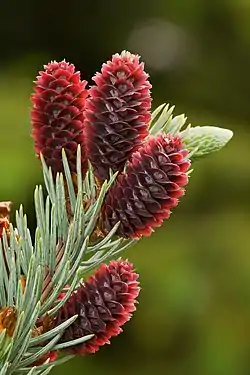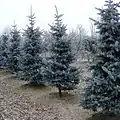| Colorado blue spruce | |
|---|---|
 | |
| Scientific classification | |
| Kingdom: | Plantae |
| Clade: | Tracheophytes |
| Clade: | Gymnospermae |
| Division: | Pinophyta |
| Class: | Pinopsida |
| Order: | Pinales |
| Family: | Pinaceae |
| Genus: | Picea |
| Species: | P. pungens |
| Binomial name | |
| Picea pungens | |
 | |
The blue spruce (Picea pungens), also commonly known as green spruce,[2] Colorado spruce, or Colorado blue spruce, is a species of spruce tree. It is native to North America, and is found in USDA growing zones 1 through 7.[3] It is found naturally in Arizona, Colorado, Idaho, New Mexico, Utah and Wyoming.[4] It has been widely introduced elsewhere and is used as an ornamental tree in many places far beyond its native range. It does well in zones warmer than 7 where summer heat is moderate, as at San Francisco.[5] The blue spruce has blue-green colored needles and is a coniferous tree.
Description
In the wild, Picea pungens grows to about 23 m (75 ft), but when planted in parks and gardens it seldom exceeds 15 m (49 ft) tall by 5 m (16 ft) wide. The tree can grow larger if the tip is cut when it is at least 3 years old. It is a columnar or conical evergreen conifer with densely growing horizontal branches. It has scaly grey bark on the trunk with yellowish-brown branches.
Waxy gray-green leaves, up to 3 cm (1 in) long, are arranged radially on the shoots which curve upwards. The pale brown cones are up to 10 cm (4 in) long.[6][7][8][9] Male cones are found on the entire tree, whereas the female cones are found at the top of the tree. This helps to facilitate cross-pollination.[10]
The specific epithet pungens means "sharply pointed", referring to the leaves.[11]
The blue spruce is the state tree of Colorado.[12]
Cultivation
Picea pungens and its many cultivars are often grown as ornamental trees in gardens and parks.[7][8][13] It is also grown for the Christmas tree industry.[7]

Pests and diseases
The blue spruce is attacked by two species of Adelges, an aphid-like insect that causes galls to form. Nymphs of the pineapple gall adelgid form galls at the base of twigs which resemble miniature pineapples and those of the Cooley's spruce gall adelgid cause cone-shaped galls at the tips of branches. The larva of the spruce budworm eat the buds and growing shoots while the spruce needle miner hollows out the needles and makes them coalesce in a webbed mass. An elongated white scale insect, the pine needle scale feeds on the needles causing fluffy white patches on the twigs and aphids also suck sap from the needles and may cause them to fall and possibly dieback. Mites can also infest the blue spruce, especially in a dry summer, causing yellowing of the oldest needles.[14][15] Another insect pest is the spruce beetle (Dendroctonus rufipennis) which bores under the bark. It often first attacks trees which have blown over by the wind and when the larvae mature two years afterwards, a major outbreak occurs and vast numbers of beetles attack nearby standing trees.[16]
The blue spruce is susceptible to several needle casting diseases which cause the needles to turn yellow, mottled or brown before they fall off. Various rust diseases also affect the tree causing yellowing of the needles as well as needle fall. Canker caused by Cytospora attacks one of the lower branches first and progressively makes its way higher up the tree. The first symptom is the needles turning reddish-brown and falling off. Meanwhile, patches of white resin appear on the bark and the branch eventually dies.[14]
Rooting habits
Blue spruce seedlings have shallow roots that penetrate only 6.4 cm (2.5 inches) of soil during the first year.[17] Although freezing can't damage much in blue spruce, frost heaving will cause seedling loss. Shadows in late spring and early autumn minimize this frost heaving loss.[18][19] Despite the shallow roots, blue spruce is able to resist strong winds.[20] Five years before transplanting, the total root surface area of 2-meter-high trees was doubled by pruning the roots of blue spruce. It also increases the root concentration in drip irrigation pipeline from 40% to 60%, which is an advantage in landscape greening.[21]
Cultivars

Common cultivars (those marked agm have gained the Royal Horticultural Society's Award of Garden Merit):[22]
- 'Glauca Globosa' agm[23] – shrub from 3–5 feet (0.91–1.52 m) in height[24]
- 'Fat Albert' – compact perfect cone to 10 feet (3.0 m) of a silver blue color[25]
- 'Glauca Pendula' – drooping branches, spreads to about 8 feet (2.4 m) wide by 4 feet (1.2 m) tall[26]
- 'Sester's Dwarf' – denser foliage than the species, slowly grows to about 6–8 feet (1.8–2.4 m) tall[27]
- 'Hoopsii' agm[28]
- 'Koster'[29]
- 'Baby Blue Eyes'[30][31]
- 'Baby Blue'[32]
Uses
The Navajo and Keres Native Americans use this tree as a traditional medicinal plant and a ceremonial item, and twigs are given as gifts to bring good fortune. In traditional medicine, an infusion of the needles is used to treat colds and settle the stomach. This liquid is also used externally for rheumatic pains. Early people used their wood for building.[33]
Gallery
 Mature tree
Mature tree Mature cone
Mature cone Immature cone
Immature cone Hoopsii
Hoopsii Koster
Koster Globosa
Globosa Montgomery
Montgomery Fat Albert
Fat Albert
Distributed soil types and topography
Blue spruce generally exists on gentle uplands and sub irrigated slopes, in well-watered tributary drainage, extending down intermittent streams, and on lower northerly slopes.[34]
Blue spruce always grow naturally in the soils which are in the order Mollisols, and the soil will also be in the orders histosols and inceptisols in a lesser extent.[34][35][36]
Blue spruce is considered as a pioneer tree species in moist soil in Utah.[37]
Climate
Blue spruce usually grows in cool and humid climatic zones where the annual precipitation mainly occurs in the summer.[38]
Blue spruce is most common in Colorado and the Southwest. The annual average temperature ranges from 3.9 to 6.1 degrees C (39 to 43 degrees F). And ranges from - 3.9 to - 2.8 degrees C (25 to 27 degrees F) in January. In July, the average temperature ranges from 13.9 to 15.0 degrees C (57 to 59 degrees F). The average minimum temperature in January ranges from - 11.1 to 8.9 degrees C (12 to 16 degrees F), and the average maximum temperature in July ranges from 21.1 to 22.2 C (70 to 72 degrees F). There is a frost-free period of about 55 to 60 days from June to August.[39][40]
Annual mean precipitation generally vary from 460 to 610 mm (18 to 24 in). Winter is the season with the poorest rainfall, the precipitation is usually less than 20 percent of the annual moisture falling from December to March. And fifth percent of the annual precipitation occurs during the growing season of the plants.[39][41]
Blue spruce is generally considered to grow best with abundant moisture. Nevertheless, this species can withstand drought better than any other spruce.[42] It can withstand extremely low temperatures (-40 degrees C) as well. Furthermore, this species is more resistant to high insolation and frost damage compared to other associated species.[38]
See also
References
- ↑ Farjon, A. (2013). "Picea pungens". IUCN Red List of Threatened Species. 2013: e.T42333A2973433. doi:10.2305/IUCN.UK.2013-1.RLTS.T42333A2973433.en. Retrieved 19 November 2021.
- ↑ "Picea pungens: Blue Spruce, Colorado Blue Spruce, or Green Spruce (Pinaceae - Pine Family)".
- ↑ "Colorado Blue Spruce". treecanada.ca. Retrieved 2018-11-20.
- ↑ Flora of North America Editorial Committee, editor. 1993. Flora of North America North of Mexico. Volume 2. Pteridiophytes and Gymnosperms. Oxford University Press, New York, 475 pp
- ↑ https://inaturalist.ca/observations/148544834
- ↑ RHS A-Z encyclopedia of garden plants. United Kingdom: Dorling Kindersley. 2008. p. 1136. ISBN 978-1405332965.
- 1 2 3 USDA Accessed 2012-12-01
- 1 2 Barnes, Burton V.; Warren J. Wagner Jr. (September 15, 1981). Michigan Trees: A Guide to the Trees of Michigan and the Great Lakes Region. Biological Science Series. University of Michigan Press. ISBN 978-0-472-08018-2.
- ↑ Vedel, H.; Lange, J. (1962). Trees and Bushes. Methuen & Co. pp. 119–120. ISBN 978-0416617801.
- ↑ "Yale Nature Walk, Blue Spruce". 2021. Retrieved 2021-02-21.
- ↑ Harrison, Lorraine (2012). RHS Latin for gardeners. United Kingdom: Mitchell Beazley. p. 224. ISBN 9781845337315.
- ↑ "State Trees & State Flowers". United States National Arboretum. June 11, 2009. Archived from the original on 2010-12-06. Retrieved 2010-05-26.
- ↑ Conifers.org . accessed 1.12.2012
- 1 2 Gilman, Edward F.; Watson, Dennis G. (2011-05-01). "Picea pungens: Colorado Spruce". EDIS. IFAS Extension Service: University of Florida. Retrieved 2013-10-06.
- ↑ Cranshaw, W. S. (2013-06-13). "Scale Insects Affecting Conifers". Colorado State University Extension. Retrieved 2013-10-05.
- ↑ Ciesla, Bill (2013-04-19). "Spruce Beetle Threatens High Country Spruce Forests". Colorado State University Extension. Retrieved 2013-10-05.
- ↑ Jones, John R. "Southwestern mixed conifers. In Silvicultural systems for the major forest types of the United States". U.S. Department of Agriculture, Agriculture Handbook.
- ↑ Alexander, Robert R. "Silviculture of central and southern Rocky Mountain forests. USDA Forest Service, Research Paper RM-120". Rocky Mountain Forest and Range Experiment Station, Fort Collins.
- ↑ Pearson, G. A. "Forest types in the Southwest as determined by climate and soil". U.S. Department of Agriculture, Technical Bulletin 247.
- ↑ Goor, A. Y.; Barney. Forest tree planting in and zones. Ronald Press.
- ↑ Watson, Gary W; Sydnor. "The effect of root pruning on the root system of nursery trees". Journal of Arboriculture.
- ↑ "AGM Plants - Ornamental" (PDF). Royal Horticultural Society. July 2017. p. 78. Retrieved 25 April 2018.
- ↑ "RHS Plant Selector – Picea pungens (Glauca Group) 'Globosa'". Retrieved 6 February 2021.
- ↑ Missouri Botanical Garden: Picea pungens 'Glauca Globosa'
- ↑ Missouri Botanical Garden: Picea pungens 'Fat Albert'
- ↑ Fine Gardening Plant Guide: Picea pungens ‘Glauca Pendula'
- ↑ Washington State University Extension: Sester's Dwarf Blue Spruce
- ↑ "RHS Plant Selector - Picea pungens (Glauca Group) 'Hoopsii'". Retrieved 6 February 2021.
- ↑ "RHS Plant Selector – Picea pungens (Glauca Group) 'Koster'". Retrieved 11 December 2023.
- ↑ "Missouri Botanical Garden - Picea pungens 'Baby Blueeyes'".
- ↑ "Washington State University - Picea pungens 'Baby Blueeyes'".
- ↑ "West Montrose Farms Ltd - Picea pungens 'Baby Blue'".
- ↑ U. Michigan-Dearborn: Ethnobotany Accessed 2020-12-20
- 1 2 Fechner, Gilbert H. "Blue Spruce". Retrieved 2018-11-22.
- ↑ Mauk, Ronald L.; Henderson. "Forest habitat types of northern Utah. USDA Forest Service General Technical Report INT-170". Intermountain Forest and Range Experiment Station.
- ↑ Moir, William H.; Ludwig, John A. "A classification of spruce-fir mixed conifer habitat types of Arizona and New Mexico". USDA Forest Service, Research Paper RM-207.
- ↑ Dixon, Helen (1935). "Ecological Studies on the High Plateaus of Utah". Botanical Gazette. 97 (2): 272–320. doi:10.1086/334554. JSTOR 2471603. S2CID 84538967.
- 1 2 Fechner, Gilbert H. "Blue Spruce". Retrieved 2018-11-23.
- 1 2 Bates, Carlos C. "Forest types in the central Rocky Mountains as affected by climate and soils". U.S. Department of Agriculture, Bulletin 1233: 152p.
- ↑ Pearson, G. A. "Forest types in the Southwest as determined by climate and soil". U.S. Department of Agriculture, Technical Bulletin 247: 144p.
- ↑ Pearson, G. A. "Forest types in the Southwest as determined by climate and soil". U.S. Department of Agriculture, Technical Bulletin 247: 144p.
- ↑ Goor, A. Y. (1977). "Forest tree planting in arid zones". Soil Science. 124 (1): 504p. Bibcode:1977SoilS.124...66C. doi:10.1097/00010694-197707000-00012.
External links
- Conifers.org: Picea pungens (blue spruce) description
- Lady Bird Johnson Wildflower Center NPIN — Native Plant Information Network
- Interactive Distribution Map of Picea pungens Archived 2011-05-14 at the Wayback Machine
- Picea pungens — U.C. Photo Gallery
